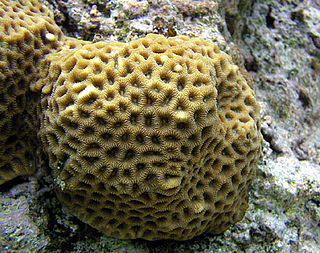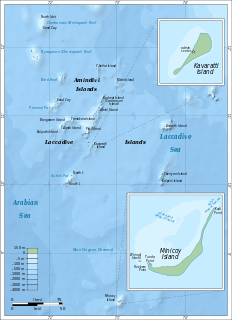
Enderbury Island, also known as Ederbury Island or Guano Island, is a small, uninhabited atoll 63 km ESE of Kanton Island in the Pacific Ocean at 3°08′S171°05′W. It is about 1 mile (1.6 km) wide and 3 miles (4.8 km) long, with a reef stretching out 60–200 metres. Forming a part of the Canton and Enderbury Islands condominium from 1939 to 1979, the island is now a possession of the Republic of Kiribati.

Brain coral is a common name given to various corals in the families Mussidae and Merulinidae, so called due to their generally spheroid shape and grooved surface which resembles a brain. Each head of coral is formed by a colony of genetically identical polyps which secrete a hard skeleton of calcium carbonate; this makes them important coral reef builders like other stony corals in the order Scleractinia. Brain corals are found in shallow warm water coral reefs in all the world's oceans. They are part of the phylum Cnidaria, in a class called Anthozoa or "flower animals". The lifespan of the largest brain corals is 900 years. Colonies can grow as large as 1.8 m (6 ft) or more in height.

Manra, is one of the Phoenix Islands in the Republic of Kiribati. It lies at 4°27′S171°16′W. longitude, and has an area of 4.4 km2 (1.7 sq mi). and an elevation of approximately six metres. Together with the seven other Phoenix Islands, it forms part of the Phoenix Islands Protected Area,. Charles Darwin visited the island during his five-year voyage (1831-1836), following which in 1842 he published an explanation for the creation of coral atolls in the South Pacific.

A microatoll is a circular colony of coral, dead on the top but living around the perimeter. Growth is mainly lateral, as upward growth is limited by exposure to air. Microatolls may be up to 6 meters (20 ft) in diameter. They are named for their resemblance to island atolls formed during the subsidence of volcanic islands, as originally suggested by Darwin (1842).

Kadmat Island, also known as Cardamom Island, is a coral island belonging to the Amindivi subgroup of islands of the Lakshadweep archipelago in India. Measuring 9.3 kilometres (5.8 mi) in length, the island has a lagoon with a width of 1.5 kilometres (0.93 mi) covering an area of 25 square kilometres (9.7 sq mi). The ecological feature of the island is of coral reef with seagrass, and marine turtles which nestle here. The Ministry of Environment and Forests (India) has notified the island as a marine protected area for ensuring conservation of the island's animal, plant, or other type of organism, and other resources.

Merulinidae is a family of reef-building stony corals.

Favites is a genus of stony corals in the family Merulinidae. Members of this genus are native to the Indo-Pacific region and their ranges extend from the Red Sea through the Indian Ocean and Western Pacific Ocean as far as Japan, the Line Islands and the Tuamotu Islands.

Favites pentagona is a species of stony coral in the family Merulinidae, sometimes known as larger star coral. It is native to the Indo-Pacific region and its range extends from the Red Sea through the Indian Ocean to the Western Pacific Ocean. This is a common species throughout its wide range and the International Union for Conservation of Nature has rated its conservation status as being of "least concern".

Favites abdita, also known as the larger star coral, is a species of stony coral in the family Merulinidae. It is native to the Indo-Pacific region and its range extends from East Africa and the Red Sea through the Indian Ocean to the Western Pacific Ocean. The International Union for Conservation of Nature has rated its conservation status as being "near-threatened".

Favites complanata is a species of stony coral in the family Merulinidae, sometimes known as the larger star coral. It is native to the Indo-Pacific region and its range extends from the Red Sea and Indian Ocean to the western and central Pacific Ocean. This is an uncommon species of coral and seems to be decreasing in abundance, and the International Union for Conservation of Nature has rated its conservation status as being "near threatened".

Platygyra daedalea, sometimes known as the lesser valley coral, is a colonial species of stony coral in the family Merulinidae. It occurs on reefs in shallow water in the Indo-Pacific region. It is a common species and the International Union for Conservation of Nature has assessed its conservation status as being of "least concern".

Oulophyllia is a genus of stony corals in the family Merulinidae. Members of this genus are native to the tropical western and central Indo-Pacific region.
Favites valenciennesi is a species of stony coral in the family Merulinidae. It is native to the Indo-Pacific region and its range extends from Madagascar through the Indian Ocean to the Western and Central Pacific Ocean. This is a generally uncommon species but has a wide range and the International Union for Conservation of Nature has rated its conservation status as being a "near-threatened species".
Favites spinosa is a species of stony coral in the family Merulinidae. It is native to the Indo-Pacific region, its range extending from the eastern coast of Africa through the Indian Ocean to the Western and Central Pacific Ocean.
Larger star coral may refer to two different species of coral:
Cliona orientalis is a species of demosponge in the family Clionaidae. It occurs in the Indo-Pacific region and is a bioeroding species, with various specialisations for living on and inside calcareous substrates such as massive corals and molluscs.











